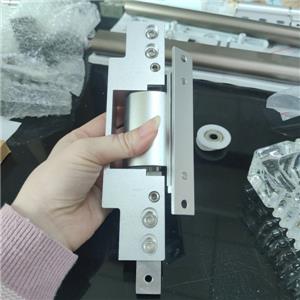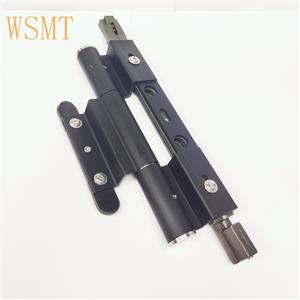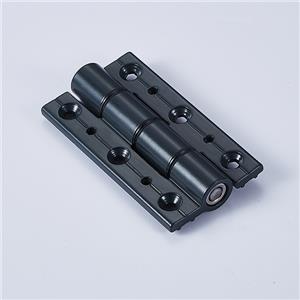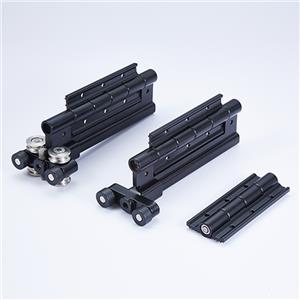Aluminium Hinges: The Essential Guide for Modern Doors and Windows
When people talk about doors and windows, the first things that come to mind are usually the glass, the frame, or even the locks. Yet one of the most important components—the aluminium hinge—is often overlooked. Without the right hinge, even the best door or window won't function properly. Hinges carry the weight, allow smooth movement, and ensure that doors last for years. And in today's construction world, aluminium hinges are quickly taking the spotlight.
In this guide, we'll dive deep into everything about aluminium hinges: why they matter, what makes them different, how to choose the right hinge for aluminium door, and where the market is heading. Whether you're a homeowner planning renovations, a contractor sourcing materials, or simply curious about the latest in building hardware, this article has you covered.
Why Aluminium Hinges Are Becoming So Popular
The rise of aluminium as a preferred material in construction is not new. From skyscraper facades to minimalist interiors, aluminium has proven itself to be strong, lightweight, and corrosion-resistant. It's no surprise that aluminium hinges are following the same trend.
According to Statista (2024), global demand for aluminium in construction is growing at a steady rate of 5.7% per year, with aluminium doors and windows accounting for a significant portion of this demand. Since every aluminium door requires at least two to three hinges, the demand for hinges is directly tied to the growth of aluminium frames. This is one reason the search volume for hinge for aluminium door has climbed steadily in the past five years.
Why the shift? Here are a few reasons:
Corrosion Resistance – Unlike iron hinges, aluminium hinges don't rust easily, even in humid or coastal areas.
Lightweight but Strong – Aluminium weighs about one-third as much as steel but still offers excellent load-bearing properties.
Aesthetic Appeal – A brushed or anodized aluminium hinge looks sleek and pairs naturally with modern aluminium doors.
Sustainability – Aluminium is recyclable, and as sustainable building practices grow, more projects are switching to aluminium hardware.
In other words, aluminium hinges aren't just a design choice—they're part of a larger shift toward smarter, more sustainable building.
The Structure and Design of Aluminium Hinges
At their core, hinges are simple mechanical devices: two plates connected by a pin that allows rotation. But the materials and engineering behind an aluminium hinge make a big difference in performance.
Material Composition – Most aluminium hinges are made with aluminium alloys such as 6061 or 6063, known for their balance of strength and corrosion resistance.
Surface Treatment – Anodizing creates a hard, protective layer that resists wear and scratches. Powder coating adds color and extra weather protection.
Precision Engineering – Modern aluminium hinge suppliers often use CNC machining or die casting to ensure tight tolerances, which means smoother movement and longer lifespan.
A hinge might look like a small piece of hardware, but when it comes to hinge for aluminium door, every millimeter counts. Poorly made hinges can lead to sagging, misalignment, or even premature door failure.
Common Types of Aluminium Hinges
Not all hinges are the same. Depending on the type of aluminium door, different hinges are needed. Here are the most common categories:
Butt Hinges – The most traditional option, usually for residential swing doors.
Concealed Hinges – Perfect for modern minimalist designs where the hinge shouldn't be visible.
Continuous Hinges – Also called piano hinges, these run the full length of the door and are used for extra-heavy panels.
Lift-off Hinges – Allow doors to be removed easily without unscrewing the hinge.
Friction Hinges – Often used in aluminium windows, where controlled movement is required.
According to Grand View Research (2023), concealed and continuous hinges are the fastest-growing segments, largely due to demand in modern office buildings and high-end residential projects.
Where Aluminium Hinges Are Used
The versatility of the aluminium hinge makes it suitable for a wide range of applications:
Residential Doors and Windows – From bedroom swing doors to balcony doors, aluminium hinges are the go-to choice.
Commercial Spaces – Offices, shopping malls, and hotels require strong yet stylish hinges.
Industrial Applications – Lightweight enclosures, cabinets, and machinery often use aluminium hinges to reduce weight.
Specialty Doors – Folding doors, fire-rated doors, or hidden doors all rely on specialized hinge designs.
The global aluminium door and window market was valued at over $75 billion in 2023 (Grand View Research), and accessories like hinges account for more than 20% of related costs. That means there’s a huge market for hinges alone.
Choosing the Right Hinge for Aluminium Doors
If you're in the market for hinges, here's what you need to consider:
Door Weight – A standard interior aluminium door may weigh 20–30 kg, while large sliding or folding doors can weigh over 100 kg. Your hinge must match the load.
Door Size – Taller doors often require three hinges instead of two to prevent sagging.
Location – Outdoor doors face rain, UV light, and temperature changes, so surface treatment is crucial.
Hinge Style – Minimalist interiors might call for concealed hinges, while industrial designs may favor visible, robust hardware.
Supplier Reliability – A trustworthy aluminium hinge supplier ensures consistent quality and avoids costly replacements.
The Market Outlook for Aluminium Hinges
The future looks bright for aluminium hardware. With the global push for sustainable and lightweight construction materials, aluminium is positioned for steady growth.
Eco-Friendly Construction – More builders are aiming for LEED certifications, which encourage recyclable materials like aluminium.
Smart Homes – Hinges are being redesigned for compatibility with automated doors and smart locking systems.
Minimalist Design Trends – Slim frames and concealed hinges are expected to dominate the next decade.
A report from Future Market Insights (2024) predicts that demand for aluminium hinges will grow at over 6% CAGR through 2032, driven by both residential and commercial sectors.
Practical Tips for Installation and Maintenance
Even the best hinge won’t perform well without proper installation. Here are a few practical tips:
Use the Right Screws – Match screw material with the hinge to prevent galvanic corrosion.
Spacing Matters – Place the top hinge 5–7 inches from the top, the bottom hinge 10–12 inches from the bottom, and add a middle hinge for tall doors.
Regular Cleaning – A simple wipe with a damp cloth prevents dust buildup.
Lubrication – Use silicone-based lubricants instead of oil to avoid staining aluminium surfaces.
These small steps can significantly extend the lifespan of any hinge for aluminium door.
Frequently Asked Questions
Q: Can aluminium hinges handle heavy doors?
A: Yes, but the hinge size and design matter. Continuous or reinforced aluminium hinges can support heavy loads.
Q: Do aluminium hinges rust?
A: No, they don’t rust like iron, but they can oxidize. Anodizing helps prevent surface oxidation.
Q: Are aluminium hinges more expensive than steel hinges?
A: Not always. While premium anodized or concealed hinges may cost more, many aluminium hinge suppliers offer competitive pricing compared to stainless steel.
Final Thoughts: Where Aluminium Hinges Are Headed
The humble hinge might not grab attention, but it plays a vital role in the function and design of modern doors. As the construction industry continues to embrace lightweight, sustainable, and stylish materials, the aluminium hinge is only going to become more important.
For homeowners, investing in high-quality hinge for aluminium door ensures smooth daily use and fewer maintenance headaches. For architects and builders, choosing the right aluminium hinge supplier means delivering projects that meet both functional and aesthetic expectations.
Looking ahead, the evolution of hinges will likely follow three paths: smarter integration with home automation, more minimalistic designs to match ultra-thin aluminium frames, and sustainable production methods to reduce environmental impact.
In short, aluminium hinges aren't just hardware—they're part of the future of modern living.
WSMT supply premium quality aluminium accessories for windows and doors.
Welcome to contact us: whatsapp/Wechat/Zalo+86 150 156 88141
Email:catherine@weisidunwj.com




